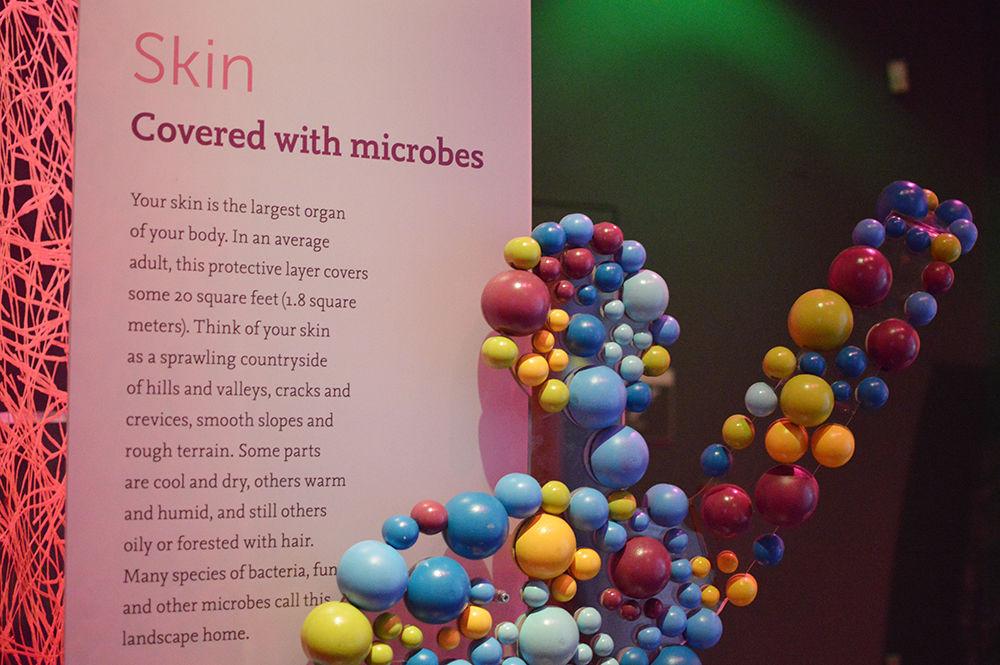 A statue of a man composed of microbes accompanies a plaque detailing how skin and microbes interact at the North Carolina Museum of Natural Sciences in Raleigh on Nov. 11. One of the main collaborators of this exhibit was Rob Dunn, a professor of applied biology in the College of Sciences. The exhibit is free to NC State students and is on display through March 12." />
A statue of a man composed of microbes accompanies a plaque detailing how skin and microbes interact at the North Carolina Museum of Natural Sciences in Raleigh on Nov. 11. One of the main collaborators of this exhibit was Rob Dunn, a professor of applied biology in the College of Sciences. The exhibit is free to NC State students and is on display through March 12." />
Kaydee Gawlik
A statue of a man composed of microbes accompanies a plaque detailing how skin and microbes interact at the North Carolina Museum of Natural Sciences in Raleigh on Nov. 11. One of the main collaborators of this exhibit was Rob Dunn, a professor of applied biology in the College of Sciences. The exhibit is free to NC State students and is on display through March 12.
The North Carolina Museum of Natural Sciences’ “The Secret World Inside You” exhibit is a germaphobe’s nightmare. As a section of the museum that is dedicated to exploring the billions of microbes both within and outside of the human body, it can make the most uncleanly of visitors a bit queasy. Despite this, the exhibit serves as an interesting, illuminating and beautiful educational source for learning about something that every human has in common.
The exhibit was sponsored by NC State’s College of Agriculture and Life Sciences and came from New York’s American Museum of Natural History, making a stop at Raleigh’s own museum. It has received copious praise for its ingenuity and interactivity from The New York Times, Livescience.com and others.
The display emphasizes the benefits of microbes found in the ecosystem that is the human microbiome.
A microbe is really any microorganism, but the term is commonly used to refer to a bacterium that causes disease or fermentation. Unfortunately, this commonly accepted definition has bred a fear and loathing of all bacteria, including those that are essential to life, which in turn has created a society unaware of the amazing capabilities of the microscopic beings living in all of us.
“People are always thinking that all microbes are bad,” said Hugo Romer, a museum staff member working at the exhibit. “But, in reality, we need them, and people need to know that.”
The exhibition starts with a dazzling display of an entrance — hundreds of bright, multicolored LED lights reflecting off glass to resemble a small portion of the average human’s microbes. The dream-like spectacle can almost be disorienting, but it cleverly symbolizes the fact that there are more microbes in any human’s body than there are stars in the Milky Way Galaxy, a point made early in the exhibit’s course.
After this, the room opens up to several plastic walls made of interweaving pink strings, complex spider webs of bodily tissues that are usually microscopic. Sections exploring mouth, digestive system and immune system microbes provide an in-depth lesson on bodily bacteria functions and benefits.
The final portion of the exhibit is a theater that shows a short movie. The movie is narrated by a mannequin with a projected human face and body, which allows for diagrams on the body as they pertain to the bacteria being discussed in the video. The theme of the movie revolves around the dangers of antibiotics as they enhance resistance in harmful bacterial communities.
Unfortunately, not all exhibit viewers are enthralled with the presentation before them. Thankfully, the exhibit understands its audience. Any uninterested participant is immediately drawn in with the help of its many interactive features. All the senses are catered to; museum-goers are provided bacterial odors to smell, macroscopic constructions of bacteria, tables that leave a fading image of a hand’s microbes upon placing it on them and more.
In addition to these, the exhibit hosts games projected onto touch-activated tables. Two players can compete at each table to see who can add the most probiotics to his or her character’s daily diet, or even race to cure an infection caused by the harmful bacterium Clostridium difficile(C. diff) by means of a fecal transplant.
“Anything to get the kids interested is very beneficial to both them and us,” said Nick Perro, another museum staff member tending to the exhibition.
The study of microbes is no more illuminating than it is important. Evolving bacteria continue to challenge the world’s top medical researchers, so it’s especially important that even the common person understands the properties of microbes. This exhibit not only provides that understanding, but cultivates an appreciation of all bacteria in the process.
“The Secret World Inside You” is at the NC Museum of Natural Sciences until March 12. Admission is free to NC State students with valid student identification.